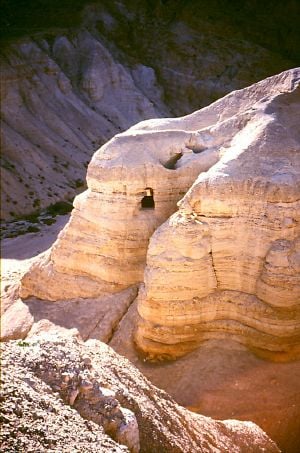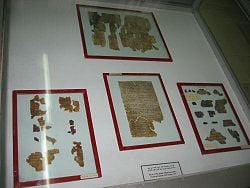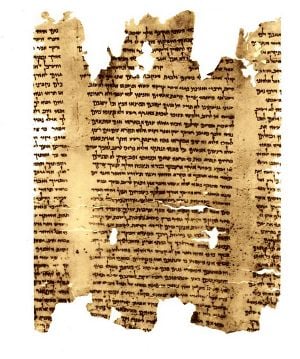Difference between revisions of "Damascus Document" - New World Encyclopedia
m (→History) |
m (→Contents) |
||
| Line 18: | Line 18: | ||
==Contents== | ==Contents== | ||
| + | The Damascus document consists of two distinct parts: a sermon designed to inspire faithfulness among community members, and a set of rules setting forth some of the community's moral, religious, and legal standards. The second part of the document is sometimes called the "Community Rule," but should not be confused with the longer, separate document of that title, sometimes called the Qumran community's "charter." | ||
| − | + | ===A call to righteousness=== | |
| − | [[ | + | The Geniza versions begin with an exhortation to righteousness and speaks of the origins of the community. It prominently mentions a [[Teacher of Righteousness]] and calls on the community to adhere strictly to the standards of purity he established. Since the document appears to have been pieced together rather than created at once, it is difficult to say for certain which of its teachings were considered most important. Early in the text, it speaks of avoiding two fundamental errors: bigamy and defiling the Temple. It equates the taking of two wives at the same time as fornication, declaring that: "The Principle of Creation is 'male and female he created them.'" Equally condemned is the practice of defiling the sacred sanctuary, specifically by failing to separate the "clean from the unclean" and lying sexually with a women during her menstrual period. |
| − | + | It stressed the need for holiness in several other matters as well: avoiding the misuse of offerings and Temple funds, distinguishing between the sacred and the profane, refraining from defrauding wealthy widows, and keeping the Sabbath strictly according to the "new covenant in the land of Damascus." One must love one's brother as oneself, support the poor and needy, and given aid to aliens and strangers. It speaks with hope of the coming of a Messiah of Aaron and of Israel. | |
| − | + | A substantial part of the discourse is devoting to the idea of shunning the promptings of one's own "willful heart." The dictates of the Teacher of Righteousness must be upheld of those of the Man of Lies. Those who repent of having failed to keep the "sure covenant they made in the land of Damascus" will be forgiven and will ultimately prevail over the "men of mockery" and all of the inhabitants of the earth. | |
| − | + | ===Disciplinary rules=== | |
| − | "The | + | [[Image:1QIsa b.jpg|thumb|One of the scrolls of the Book of Isaiah found at Qumran. The Damascus Document is considerably more fragmentary.]] |
| + | Many of the rules set down in the second part of the Damascus Document are repetitions and expansions on laws found in the Torah. However, a number of them give insights in the unique character of the Qumran community, generally thought to be an Essene group. The document, however, is clearly intended for a broader community than the Qumran community alone, as it refers to numerous covenant groups of various sizes living in cities and camps. | ||
| − | + | Among its more interesting rules are: | |
| + | *No swearing, either by Lamedh (the intial consonant of [[Elohim]] or by "Aleph" and "Daleth," (Adonai, the [[Yahweh|Lord]]. | ||
| + | *"Only the enemies of God take vengeance." | ||
| + | *Lost property whose owner is unknown belongs to the priests | ||
| + | *No gleaning of fields on the Sabbath | ||
| + | *No carrying of medicines on the Sabbath | ||
| + | *No helping people on the Sabbath with tools such as ropes or ladders, even if they may drown as a result | ||
| + | *"A man may not lie with a woman in the city of the Temple..." | ||
| + | *To commerce is allowed with Gentiles which may be used for idolatry (such as the sale of potential sacrificial animals, wine, metals, or related implements). | ||
| + | *No business should be conducted even with Jews who are known to be corrupt | ||
| + | *Seating and speaking in community meetings is strictly according to ranks: priests, Levites, Israelites, and prosylites | ||
| + | *Priests must master the "Book of Meditation." The head priest of each camp or community must be at least 36 years of age. | ||
== References == | == References == | ||
Revision as of 01:55, 5 June 2008

The Damascus Document, also called the Zadokite Fragments, one of the works found in multiple fragmentary copies in the caves at Qumran, and as such is counted among the Dead Sea Scrolls. It is unique among the Qumran sectarian documents in that it had been previously discovered in the late nineteenth century in Egypt.
The current majority view among scholars is that the scrolls are related to an Essene community based there around the first century B.C.E. Because it gives specific insights into the unique religious attitudes of its writers, the Damascus Document is considered one of the most important sources for understanding the ancient Essene movement. The document seems to have been written in stages between 175 B.C.E. and 70 C.E., when the Essene community at Qumran community at Qumran was abandoned.
The first section of the Damascus Document concerns the community's religious teachings. It stresses devotion to Israel's covenant with God, the hope of the coming of both a Messiah of Aaron and a Messiah of Israel, and a strict interpretation of Jewish law. It also speaks of a mystery Teacher of Righteousness and an unknown document known as Book of Meditation which the chief priest of the community were required to master. Various theories have emerged concerning the identity and roles of these two antagonists. The document predicts that the age of the Messiah would begin 40 years after the Teacher's death.
The document's second section contains a set of regulations concerning community life and discipline that gives a sense of the sect's way of life as they prepared themselves for the Messiah's coming. Its rules were very strict, requiring almost total separation from Gentiles, no carrying of medicines on the Sabbath,
History
The noted Jewish scholar Rabbi Solomon Schechter first discovered the document in the Cairo Geniza, a synagogue storeroom of long forgotten manuscripts. He studied and published it under the title of the Zadokite Fragments in 1910. Schechter assigned this name to the document on account of several reference to the Israelite priest Zadok, to whom the sect that produced the document apparently looked as a model of faithfulness. Although the two copies Schecter worked from were medieval, he believed the original must have been ancient, from around the first century B.C.E. The discovery of several fragments of the document at Qumran in 1948 proved Schechter correct.
In contrast to the fragments found at Qumran, the Cairo documents are largely complete, and therefore are vital for reconstructing the text. Eight separate copies of the Damascus Document were kept in Qumran Cave 4 and an additional copy in Cave 5. These have been dated to the beginning of the Common Era, give or take several decades. Where the content of the Qumran fragments overlaps with the Geniza manuscripts, there is little variation between them.
The current title of the document comes from several references within it to a community of the "new covenant" in Damascus. It is a matter of debate whether this is a literal reference to Damascus in Syria, a metaphorical references to a great pagan city (as "Babylon" is in the Book of Revelation), or possibly even Qumran itself.
Contents
The Damascus document consists of two distinct parts: a sermon designed to inspire faithfulness among community members, and a set of rules setting forth some of the community's moral, religious, and legal standards. The second part of the document is sometimes called the "Community Rule," but should not be confused with the longer, separate document of that title, sometimes called the Qumran community's "charter."
A call to righteousness
The Geniza versions begin with an exhortation to righteousness and speaks of the origins of the community. It prominently mentions a Teacher of Righteousness and calls on the community to adhere strictly to the standards of purity he established. Since the document appears to have been pieced together rather than created at once, it is difficult to say for certain which of its teachings were considered most important. Early in the text, it speaks of avoiding two fundamental errors: bigamy and defiling the Temple. It equates the taking of two wives at the same time as fornication, declaring that: "The Principle of Creation is 'male and female he created them.'" Equally condemned is the practice of defiling the sacred sanctuary, specifically by failing to separate the "clean from the unclean" and lying sexually with a women during her menstrual period.
It stressed the need for holiness in several other matters as well: avoiding the misuse of offerings and Temple funds, distinguishing between the sacred and the profane, refraining from defrauding wealthy widows, and keeping the Sabbath strictly according to the "new covenant in the land of Damascus." One must love one's brother as oneself, support the poor and needy, and given aid to aliens and strangers. It speaks with hope of the coming of a Messiah of Aaron and of Israel.
A substantial part of the discourse is devoting to the idea of shunning the promptings of one's own "willful heart." The dictates of the Teacher of Righteousness must be upheld of those of the Man of Lies. Those who repent of having failed to keep the "sure covenant they made in the land of Damascus" will be forgiven and will ultimately prevail over the "men of mockery" and all of the inhabitants of the earth.
Disciplinary rules
Many of the rules set down in the second part of the Damascus Document are repetitions and expansions on laws found in the Torah. However, a number of them give insights in the unique character of the Qumran community, generally thought to be an Essene group. The document, however, is clearly intended for a broader community than the Qumran community alone, as it refers to numerous covenant groups of various sizes living in cities and camps.
Among its more interesting rules are:
- No swearing, either by Lamedh (the intial consonant of Elohim or by "Aleph" and "Daleth," (Adonai, the Lord.
- "Only the enemies of God take vengeance."
- Lost property whose owner is unknown belongs to the priests
- No gleaning of fields on the Sabbath
- No carrying of medicines on the Sabbath
- No helping people on the Sabbath with tools such as ropes or ladders, even if they may drown as a result
- "A man may not lie with a woman in the city of the Temple..."
- To commerce is allowed with Gentiles which may be used for idolatry (such as the sale of potential sacrificial animals, wine, metals, or related implements).
- No business should be conducted even with Jews who are known to be corrupt
- Seating and speaking in community meetings is strictly according to ranks: priests, Levites, Israelites, and prosylites
- Priests must master the "Book of Meditation." The head priest of each camp or community must be at least 36 years of age.
ReferencesISBN links support NWE through referral fees
- Broshi, Magen: The Damascus document reconsidered (Israel Exploration Society: Shrine of the Book, Israel Museum, 1992)
- Davies, P. R.: The Damascus covenant: an interpretation of the "Damascus document" (Sheffield, 1983)
- Ginzberg, L.: An Unknown Jewish Sect (E.T.: New York, 1976)
- Kahle, Paul: The Cairo Genizah (Oxford: Blackwell, 1959)
- Rabin, C.: The Zadokite documents, 1: the admonition, 2: the laws (2nd ed. Oxford, 1958)
- Reif, Stefan: Article "Cairo Genizah," in Encyclopaedia of the Dead Sea Scrolls (Oxford: OUP: forthcoming 1997) ed LH Schiffman and JC VanderKam
- Rowley, H. H.: The Zadokite fragments and the Dead Sea scrolls (Oxford: Blackwell, 1952)
- Schechter, S.: Documents of Jewish sectaries/ edited from Hebrew MSS. in the Cairo Genizah collection, now in the possession of the University Library, Cambridge (Cambridge: University Press, 1910) 2 v
- Zeitlin, Solomon: The Zadokite fragments: facsimile of the manuscripts in the Cairo Genizah collection in the possession of the University Library, Cambridge, England (Philadelphia: Dropsie College, 1952)
Credits
New World Encyclopedia writers and editors rewrote and completed the Wikipedia article in accordance with New World Encyclopedia standards. This article abides by terms of the Creative Commons CC-by-sa 3.0 License (CC-by-sa), which may be used and disseminated with proper attribution. Credit is due under the terms of this license that can reference both the New World Encyclopedia contributors and the selfless volunteer contributors of the Wikimedia Foundation. To cite this article click here for a list of acceptable citing formats.The history of earlier contributions by wikipedians is accessible to researchers here:
The history of this article since it was imported to New World Encyclopedia:
Note: Some restrictions may apply to use of individual images which are separately licensed.

